
The Asian channid fish genus Channa, Scopoli 1777 , contains 22 species (Cheng and Zheng, 1987; Kottelat, 1989; Kottelat et al., 1993; Talwar and Jhingran, 1991; Pethiyagoda, 1991; Vierke, 1991; Ng et al., 1995). The genus is characterized by an elongated cylindrical body, long-based and entirely softrayed dorsal and anal fins, a large mouth with well developed teeth on the jaws, palatines and prevomer, and an accessory air breathing apparatus (suprabranchial organ). Kottelat (1989), Roberts (1989, 1993), Ng and Lim (1990) , Lee and Ng (1994), and Rainboth (1996) have all pointed out generic and specific taxonomic problems, especially those of species distributed from the Indian subcontinent to Southeast Asia. During field surveys in India and Myanmar (Burma) in 1995 and 1996, specimens of an undescribed species were collected from the Irrawaddy and Sittang River basins, Myanmar. They are herein described as new, the species having been formerly overlooked or misidentified as the widely distributed species Channa punctata (Bloch, 1793) because of their superficial similarities in external morphology and coloration.
Methods for counts and measurements followed Hubbs and Lagler (1958), except for the following: a scale immediately in front of the dorsal and anal fin origin was counted as one-half in scale-row counts above and below the lateral line; preorbital and postorbital head depths were measured at the anterior and posterior eye margins, respectively; body depth and width were measured at the anal fin origin; head depth was measured at the highest point of the skull (supraoccipital); prepelvic and preanal lengths were measured from the snout tip to the anterior insertion of the pelvic and anal fins, respectively, prepectoral length was measured from the snout tip to the lower insertion of the pectoral fin base. Fin rays were counted with a binocular microscope or taken from radiographs. Vertebral counts were taken from radiographs, those with a hemal spine and the urostyle being counted as caudal vertebrae, the remainder as precaudal vertebrae. Specimens smaller than 75.5 mm standard length (SL) were not used for proportional data. The suprabranchial organ was examined in dissected specimens. Specimens examined were deposited in the following institutions: Academy of Natural Sciences, Philadelphia (ANSP); The Natural History Museum, London (BMNH); California Academy of Sciences, California (CAS); Field Museum of Natural History, Chicago (FMNH); Institute for Breeding Research, Tokyo University of Agriculture, Tokyo (IBRP); Museum of Fisheries, Kasetsart University, Bangkok (KUMF); National Science Museum, Tokyo (NSMT-P); Swedish Museum of Natural History, Stockholm (NRM); Museum of Zoology, University of Michigan, Michigan (UMMZ); Museum für Naturkunde, Universität Humboldt, Berlin (ZMB); Zoological Survey of India, Calcutta (ZSI); Southern Regional Station, Zoological Survey of India, Madras (ZSI-SRS).
Holotype . KUMF 3050, 151.7 mm SL, Yangon fish market, Yangon, Myanmar, 22 or 23 Aug. 1995, P Musikasinthorn.
 | Fig.1: Channa panaw sp. nov., holotype, KUMF 3050, 151.7mm SL. |
Paratype . KUMF 3051 (10 specimens), 133.9 - 171.2 mm SL, data as for holotype; KUMF 3060 (1), 168.7 mm SL, data as for holotype; KUMF 3061 (1), 166.8 mm SL, data as for holotype (dissected); KUMF 3062 (1), 151.8 mm SL, data as for holotype (dissected); NSMT-P 36121 (7), 113.4 - 140.0 mm SL. data as for holotype NSMT-P 36129 (1), 137.5 mm SL, data as for holotype; KUMF 3052 (2), 133.2 - 162.4 mm SL, Poun Tan Zar (17°52'58''N, 96°43'21''E), Pegu, Myanmar, 21 Aug. 1995, P. Musikasinthorn; KUMF 3053 (1), 160.9 mm SL, Kaidan market, Mandalay, Myanmar, Aug. 1995, P. Musikasinthorn; KUMF 3054 (3), 65.0 - 108.1 mm SL, Lekkupkuin Village, Pegu, Myanmar, 12 Aug. 1995, P. Musikasinthorn; NRM 27421 (3) (deposited as Channa sp.), 137.4 - 126.5 mm SL, Myitkyina, Kachin, Myanmar. 7 Mar. 1934, R. Malaise; ANSP 77016 (1) (deposited as Channa punctata ), 154.1 mm SL, Rangoon, Myanmar, 1924, F. Hallberg.
A species of Channa distinguishable from all other congeners by the following combination of characters: total vertebrae 39-41; lateral line scales 39-41; dorsal fin rays 32-35; anal fin rays 23-24; pectoral fin rays 17-20; predorsal scales 14-17; head depth 39.5-47.0% head length (HL); postorbital head depth 26.8-32.1% HL; eye diameter 10.2 - 13.7% HL; pelvic fin length always more than 50% of pectoral fin length; 7-12 black blotches on upper half of body; one large scale on each side of lower jaw (rarely 2 on one side) ( Fig. 2 ).
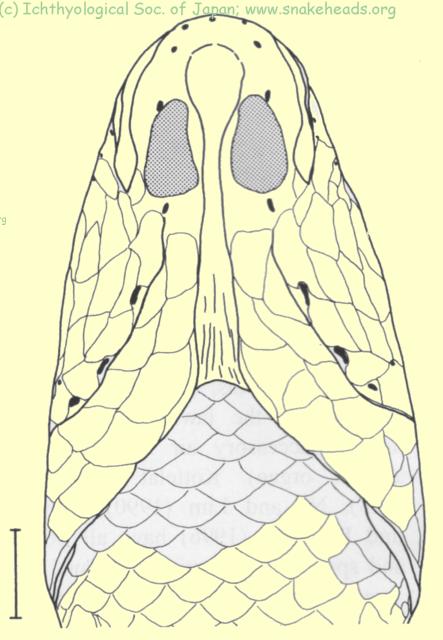 | Fig.2. Ventral view of head of Channa panaw sp. nov. (paratype, KUMF 3060, 168.7 mm SL) showing a large scale on each side of the lower jaw (dotted regions) and cephalic sensory pores (in black). Scale bar indicates 10.0 mm. |
Frequency distributions of counts are given in Tables 1 and 2 . Measurements are given in Table 3 .
Dorsal fin rays 32-35. Anal fin rays 23-24. Pectoral fin rays 17-20. Pelvic fin rays 6. Principal caudal fin rays 14-15. Total vertebrae 39-41, precaudal +caudal= 35-37 +4 (rarely 5). Cheek scales 5-6. Lateral line scales 39-41. Scale rows above lateral line 3.5-4.5, below lateral line 8-11. Circumpeduncular scales 21-24. Predorsal scales 14-17. Lateral line scales dropping one row following 14 - 17th anterior most scales. A large scale on each side of lower jaw (rarely two scales on one side) ( Fig. 2 ). Cephalic sensory pores single, without satellite openings ( Fig. 2 ).
Body elongated, relatively slender, cross-section almost circular in anterior portion, somewhat compressed posteriorly. Body depth greatest at insertion of ventral fins. Body width greatest at insertion of pectoral fins. Dorsal and anal fin bases long (56.4 - 59.8% and 37.4 - 43.3% SL, respectively). Pelvic fins moderately long (13.1-15.6% SL), may reach anal fin. Outer margins of pectoral and caudal fins rounded.
Head elongated (34.8-39.2% SL), concave in lateral view. Snout relatively narrow, pointed. Dorsal profile of snout somewhat convex. Interorbital region almost flat. Orbit not reaching dorsal contour of head in lateral view. Mouth large, maxilla extending beyond posterior margin of eyes.
Dentition ( Fig.3 ). - Many small conical teeth embedded in premaxilla, an additional series of conical teeth (3 - 5 times larger) anteromedially on upper jaw. Many variously-sized conical teeth on prevomer and in band on each palatine. Many small teeth on outer region of dentary, plus about six large caninelike teeth medially on each side.
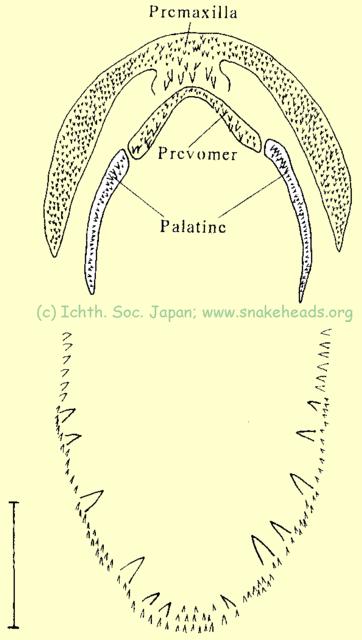 | Fig.3. Dention of Channa panow sp. nov. (paratype NSMT-P 36129, 137.5 mm SL). Upper jaw (above) and lower jaw (below). Scale bar indicates 5.0 mm. |
Morphology of suprabranchial organ ( Fig.4 ). Inner surface of suprabranchial chamber generally smooth. Surface structure of epibranchial respiratory fold and hyomandibular process simplified, small projections or wrinkles absent. Top of epibranchial respiratory fold indented, its lower portion relatively rough and projected anteriorly. Hyomandibular process stalked almost at a right angle from inner side of gill cover, its lower corner protruding more than the upper. Hyomandibular process almost completely supported by part of the hyomandibular bone.
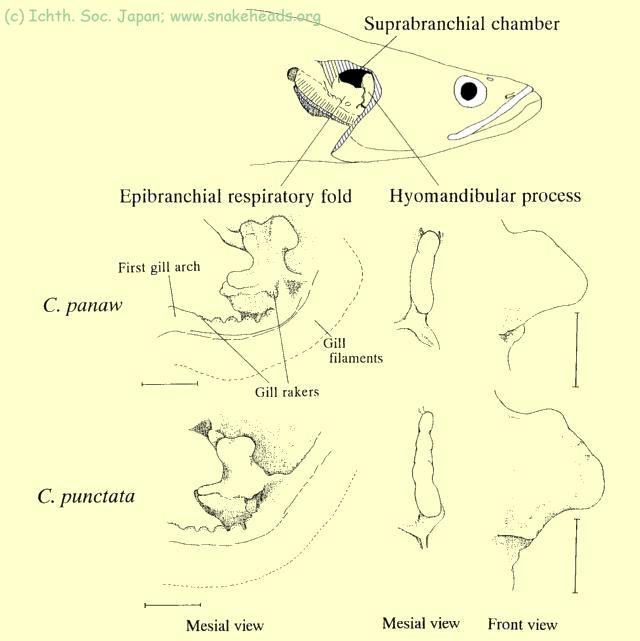 | Fig.4. The suprabranchial organs of Channa panaw sp. nov. (paratype, KUMF 3061, 166.8mm SL) and C. punctata (KUMPF 3048, 168.0 mm SL). Scale bars indicate 5 mm. |
Coloration . In alcohol: dorsal side of body brown or darkish brown, ventral side whitish. A row of 7-12 black blotches present on upper half of body, their upper margin not reaching anterior portion of dorsal fin base, but doing so more posteriorly. Several black blotches scattered irregularly on lower half of body, those just below lateral line forming a row. Upper body blotches more vivid than lower.
Numerous small irregularly-shaped black spots scattered on head, ventral surface of body, and dorsal, anal and caudal fins. In some specimens, black oblique bands posteriorly on dorsal and anal fins partly fragmented into spots. Pectoral and pelvic fins dusky to blackish with several black bands or spots on rays. One or two (vertically aligned) irregular black blotches on pectoral and caudal fin bases. Edges of dorsal, anal and pelvic fins white.
The new species is known only from the Irrawaddy and Sittang river basins, Myanmar ( Fig.5 ).
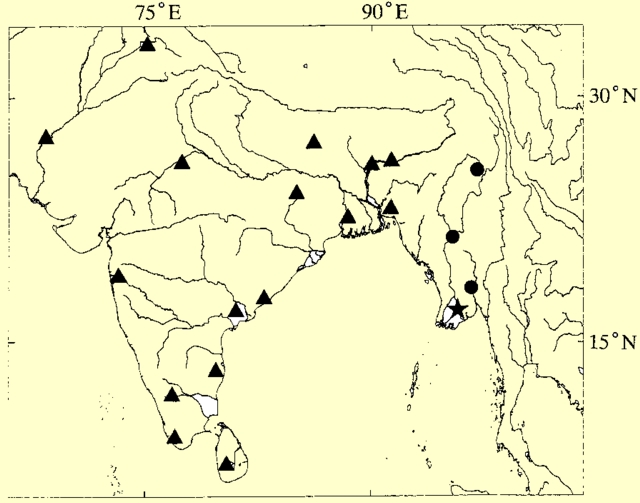 | Fig.5. Localities of specimens used in the presend study. Channa panaw sp. nov. (STAR == holotype, BALL == paratypes); C. punctata (TRIANGLE). |
The specific name panaw is from a Burmese vernacular name for the species, «nga panaw» .
C. panaw is most similar to C. punctata , a widely-distributed South Asian species, in the following characters: relatively narrow, pointed snout, pelvic fin length always more than 50% of pectoral fin length, a large scale on each side of the lower jaw, irregular black blotches along the sides of the body, and irregular small black spots ventrally on the body and on all fins. Furthermore, the two species are similar to each other in the morphology of the suprabranchial organ ( Fig. 4 ): the surfaces of the epibranchial respiratory fold and hyomandibular process are generally simple, and the hyomandibular process is almost completely supported by part of the hyomandibular bone.
However, the two species differ in both meristics ( Table 1 ) and some morphometric characters. The head of C. panaw is more depressed and concave than that of C. punctata in lateral view (Figs. 6 , 7A , 7B ), head depth 39.5-47.0% HL in C. panaw vs. 45.9 - 55.1% HL in C. punctata and postorbital head depth 26.8-32.1% HL vs. 31.5-38.0% HL. The former species also has smaller eyes, 10.2-13.7% HL vs. 11.3-16.7% HL ( Table 3 ; Fig. 7C ) Differences in coloration include a more conspicuous black blotch just behind the opercle in C. punctata , than in C. panaw . In addition, numerous small black spots on the head, body and all fins are more vivid and bigger in C. panaw than in C. punctata .
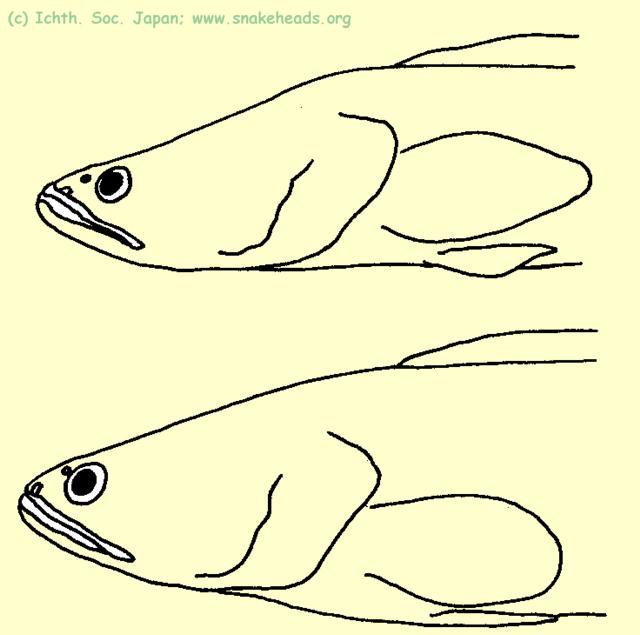 | Fig.6. Head shape of Channa panaw sp. nov. (holotype, 151.7 mm SL) (above) and C. punctata (KUMF 3056, 170.3 mm SL) (below). |
During field surveys in the Irrawaddy and Sittang River basins, no specimens of Channa punctata were collected. A specimen from Rangoon (ANSP 77016), labelled C. punctata , was re-examined by me and identified as C. panaw . Present information suggests that the distribution of C. panaw is restricted to the Irrawaddy and Sittang River basins, whereas C. punctata is widely distributed from the Indus River basin of Afghanistan and Pakistan to the peninsular part of India, Sri Lanka and Ganges-Brahmaputra River basin (Talwar and Jhingran, 1991) (According to Zhou [1989], the report of C. punctata from Erhai Lake [Mekong River basin], Yunnan, China, by Chaudhuri [1911] is doubtful and further investigation is needed). The report of Ophiocephalus (misspelling of Ophicephalus Bloch, 1793) punctatus (=Channa punctata) from the Irrawaddy River basin by FVinciguerra (1890) is presumably based on C. panaw specimens. Although many other studies mention «Burma» as within the distribution of C. punctata (Day 1865, Day 1876 ; Khin, 1948; Jayaram, 1982; Munshi and Srivastava, 1988; Talwar and Jhingran, 1991), no specific river or locality information within Myanmar was provided. These reports are likely to have been based on misidentified C. panaw specimens at best.
Channa panaw is easily distinguishable from other valid sympatric channid species, Channa gachua , C. marulia and C. striata , by having 17-20 pectoral fin rays (less than 17 in C. gachua ), pelvic fin length always more than 50% of pectoral fin length (less than 50% in C. gachua ), 39-41 lateral line scales (more than 50 in C. marulia and C. striata ) and a large scale on each side of the lower jaw (absent in C. marulia and C. striata ).
To Be Continued.
Acknowledgments. - I am grateful to the following persons for their invaluable help during field work in Myanmar and lndia: A. Khaing (Myanmar), K. C. Jayaram (Madras Science Foundation), S. V. Sharma (Nagarjuna University), N. H. Gopal (University of Mysore), S. Hameed (Jamal Mohamed College). My special thanks go to Y. Taki, H. Kohno, K. Fujita, K. Watanabe, A. Doi, N. Teitler (Tokyo University of Fisheries), K. Matsuura (NSMT) and T. R. Roberts (CAS) for their invaluable suggestions and critical reading of the manuscript. 1 am also grateful to the following persons for facilitating museum visits: T. K. Sen (ZSI), P.T. Cherian (ZSI-SRS), K. Rema Devi (ZSI-SRS), H.-J. Paepke (ZMB), 0. Crimmen (BMNH). H.-J. Paepke also kindly provided a radiograph of the syntypes of C. punctata. For loans and information on speeimens, 1 also thank: D. Catania (CAS), A. Kawamoto, A. Imaki (IBRP), K. Sakamoto (Biological Laboratory, Imperial Household Agency, Tokyo), S. Sontirat (KUMF), S. Kullander (NRM), W G. Saul (ANSP), D. W Nelson (UMMZ), M. A. Rogers (FMNH).
| Dorsal fin rays | 27 | 28 | 29 | 30 | 31 | 32 | 33 | 34 | 35 | Mean (+/-SD) | n |
| C. panaw | - | - | - | - | - | 1 | 13 | 17 1 | 1 | 33.6 (0.5) | 32 |
| C. punctata | 1 | 1 | 4 | 31 2 | 22 | 7 | - | - | - | 30.4 (0.8) | 66 |
| Anal fin rays | 19 | 20 | 21 | 22 | 23 | 24 | Mean (+/-SD) | n |
| C. panaw | - | - | - | - | 17 | 15 3 | 23.5 (0.4) | 32 |
| C. punctata | 5 | 15 | 25 4 | 18 5 | 3 | - | 21.0 (1.0) | 66 |
| Pectoral fin rays | 14 | 15 | 16 | 17 | 18 | 19 | 20 | Mean (+/-SD) | n |
| C. panaw | - | - | - | 7 | 15 6 | 9 | 1 | 18.1 (0.7) | 32 |
| C. punctata | 1 | 8 7 | 34 8 | 19 | 6 | - | - | 16.3 (0.8) | 68 |
| Lateral line scales | 35 | 36 | 37 | 38 | 39 | 40 | 41 | Mean (+/-SD) | n |
| C. panaw | - | - | - | - | 5 | 17 | 9 | 40,1 (0,6) | 31 |
| C. punctata | 3 | 16 | 32 9 | 10 | 3 10 | - | - | 36,9 (0,9) | 64 |
| Predorsal scales | 12 | 13 | 14 | 15 | 16 | 17 | Mean (+/-SD) | n |
| C. panaw | - | - | 2 | 7 | 11 11 | 4 | 15.7 (0.8) | 24 |
| C. punctata | 9 | 21 | 14 | 5 12 | - | - | 13.3 (0.9) | 49 |
| Total vertebrae | 35 | 36 | 37 | 38 | 39 | 40 | 41 | Mean (+/-SD) | n |
| C. panaw | - | - | - | - | 4 | 19 13 | 4 | 40,0 (0,5) | 27 |
| C. punctata | 8 | 26 14 | 16 15 | 7 | - | - | - | 36,4 (0,9) | 57 |
| Channa panaw | Holotype KUMF 3072 | Paratype Frequencies | Mean (+/-SD) 16 | n 17 |
| Cheek scales | 5 | 5 (27), 6 (3) | 5.1 (0.3) | 30 |
| Scale rows above lateral line | 4.5 | 3.5 (12), 4.5 (18) | 4.1 (0.5) | 30 |
| Scale rows below lateral line | 9 | 8 (3), 9 (12), 10 (12), 11 (2) | 9.4 (0.8) | 29 |
| Circumpeduncular scales | 23 | 21 (1), 22 (8), 23 (11), 24 (5) | 22.8 (0.8) | 25 |
| Pelvic fin rays | 6 | 6 (32) | 6.0 (0.0) | 32 |
| Caudal fin rays | 14 | 14 (22), 15 (5) | 14.2 (0.4) | 27 |
| Channa punctata | Syntypes ZMB 1394 | Frequencies 18 | Mean (+/-SD) 19 | n 20 |
| Cheek scales | - 21 , 5 22 | 4 (1), 5 (53), 6 (7), 7 (1) | 5.1 (0.4) | 62 |
| Scale rows above lateral line | - 23 , 4.5 24 | 3.5 (47), 4.5 (20) | 3.8 (0.5) | 67 |
| Scale rows below lateral line | 11 25 , 10 26 | 8 (1), 9 (15), 10 (29), 11 (20), 12 (1) | 10.1 (0.8) | 66 |
| Circumpeduncular scales | 28 27 , 28 28 | 21 (1), 22 (6), 23 (5), 24 (14), 25 (13), 26 (8), 27 (7), 28 (2) | 24.7 (1.7) | 56 |
| Pelvic fin rays | 6 29 , 6 30 | 6 (68) | 6.0 (0.0) | 68 |
| Caudal fin rays | 14 31 , 14 32 | 12 (3), 13 (6), 14 (43), 15 (4) | 13.9 (0.6) | 56 |
| Channa panaw | Holotype KUMF 3072 | Paratypes Range | Mean (+/- SD) 33 | n 34 |
| Standard length (SL in mm) | 151.7 | 107.6-171.2 | 140.2 (17.7) | 31 |
| Head length (in % of SL) | 36.8 | 34.8-39.2 | 36.6 (1.0) | 31 |
| Head depth (in % of SL) | 16.2 | 14.4-16.8 | 15.9 (0.6) | 29 |
| Head width (in % of SL) | 21.2 | 18.3-22.2 | 20.6 (0.9) | 30 |
| Body depth (in % of SL) | 19.7 | 18.3-22.3 | 20.2 (1.2) | 29 |
| Body width (in % of SL) | 15.2 | 13.6-16.3 | 14.7 (0.7) | 26 |
| Caudal peduncle length (in % of SL) | 9.4 | 8.0-10.0 | 9.0 (0.6) | 31 |
| Caudal peduncle depth (in % of SL) | 11.0 | 9.6-12.2 | 10.9 (0.6) | 31 |
| Predorsal length (in % of SL) | 37.1 | 35.2-41.4 | 37.3 (1.2) | 31 |
| Preanal length (in % of SL) | 53.5 | 53.1-57.9 | 54.8 (1.1) | 31 |
| Prepectoral length (in % of SL) | 35.5 | 33.3-38.3 | 35.4 (1.1) | 31 |
| Prepelvic length (in % of SL) | 38.7 | 35.8, 40.5 | 38.7 (1.1) | 31 |
| Length of dorsal fin base (in % of SL) | 58.6 | 56.4-59.8 | 58.1 (0.8) | 31 |
| Length of anal fin base (in % of SL) | 40.8 | 37.4-43.3 | 40.3 (1.3) | 31 |
| Pectoral fin length (in % of SL) | 20.7 | 17.6-23.0 | 19.9 (1.1) | 31 |
| Pelvic fin length (in % of SL) | 14.4 | 13.1-15.6 | 14.2 (0.7) | 31 |
| Channa punctata | Syntypes ZMB 1394 | Range 35 | Mean (+/- SD) 36 | n 37 |
| Standard length (SL in mm) | 107.5, 152.0 | 100.4-203.5 | 140.2 (17.7) | 31 |
| Head length (in % of SL) | 36.9, 32.9 | 32.4-37.2 | 35.0 (21.4) | 31 |
| Head depth (in % of SL) | -, 16.4 | 16.4-18.7 | 17.6 (0.8) | 30 |
| Head width (in % of SL) | -, 19.6 | 19.4-24.2 | 21.6 (1.4) | 30 |
| Body depth (in % of SL) | 19.0, 19.9 | 18.3-24.5 | 20.2 (1.4) | 29 |
| Body width (in % of SL) | 12.1, 14.1 | 11.7-17.9 | 15.2 (1.7) | 29 |
| Caudal peduncle length (in % of SL) | 8.8, 10.3 | 8.0-12.1 | 10.3 (1.0) | 31 |
| Caudal peduncle depth (in % of SL) | 12.0, 11.6 | 10.4-13.8 | 12.0 (0.8) | 31 |
| Predorsal length (in % of SL) | 40.0, 36.3 | 33.9-40.0 | 37.0 (1.5) | 31 |
| Preanal length (in % of SL) | 58.0, 54.1 | 52.3-58.0 | 55.0 (1.5) | 31 |
| Prepectoral length (in % of SL) | 37.3, 32.7 | 32.2-37.3 | 34.5 (1.1) | 30 |
| Prepelvic length (in % of SL) | 39.1, 37.1 | 36.2, 42.2 | 39.2 (1.1) | 31 |
| Length of dorsal fin base (in % of SL) | 58.4, 59.2 | 54.9-60.9 | 57.8 (1.6) | 31 |
| Length of anal fin base (in % of SL) | 37.7, 38.6 | 36.2-42.2 | 39.2 (1.5) | 31 |
| Pectoral fin length (in % of SL) | 22.6, 19.8 | 18.5-23.3 | 20.8 (1.3) | 31 |
| Pelvic fin length (in % of SL) | 14.8, 13.8 | 11.7-15.6 | 13.7 (0.8) | 31 |
| Channa panaw | Holotype KUMF 3072 | Paratypes Range | Mean (+/- SD) | n |
| Head length (HL in mm) | 55.9 | 38.9-61.9 | 51.2 (6.1) | 31 |
| Head depth (in % of HL) | 43.8 | 39.4-47.0 | 43.4 (1.9) | 29 |
| Head width (in % of HL) | 57.6 | 50.3-61.5 | 56.4 (2.8) | 30 |
| Snout length (in % of HL) | 17.7 | 16.7-19.4 | 17.8 (0.7) | 30 |
| Eye diameter (in % of HL) | 11.1 | 10.2-13.7 | 12.0 (0.8) | 31 |
| Preorbital head depth | 23.3 | 20.5-20.8 | 22.7 (1.3) | 29 |
| Postorbital head length | 73.5 | 70.8-74.0 | 72.6 (0.9) | 29 |
| Postorbital head depth (in % of HL) | 29.0 | 26.8-32.1 | 29.2 (1.2) | 29 |
| Interorbital width (in % of HL) | 22.4 | 20.5-24.5 | 22.1 (1.0) | 30 |
| Upper jaw length (in % of HL) | 34.3 | 32.3-35.7 | 33.8 (1.0) | 31 |
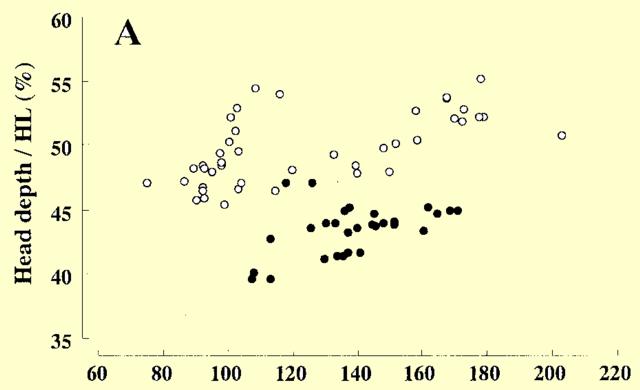 | Fig.7a: Relationship between standard length and percentage of head depth to head length (Black == C. panaw, White == C. punctata). |
| Channa punctata | Syntypes ZMB 1394 | Range | Mean (+/- SD) | n |
| Head length (HL in mm) | 39.7, 50.0 | 35.9, 66.0 | 48.7 (9.7) | 31 |
| Head depth (in % of HL) | -, 50.0 | 45.9-55.1 | 50.5 (2.6) | 30 |
| Head width (in % of HL) | -, 59.6 | 56.8-67.5 | 61.8 (3.3) | 30 |
| Snout length (in % of HL) | 19.1, 16.8 | 14.8-19.4 | 17.3(1.1) | 30 |
| Eye diameter (in % of HL) | 16.4, 14.4 | 11.3-16.7 | 13.7 (1.5) | 31 |
| Preorbital head depth | -, 24.4 | 21.6-28.4 | 25.1 (1.7) | 30 |
| Postorbital head length | 70.8, 74.1 | 68.0-75.5 | 71.9 (1.6) | 30 |
| Postorbital head depth (in % of HL) | -, 32.9 | 31.5-32.9 | 34.1 (1.7) | 30 |
| Interorbital width (in % of HL) | -, 23.4 | 20.3-24.8 | 23.2 (1.2) | 29 |
| Upper jaw length (in % of HL) | 33.8, 35.8 | 31.9-37.6 | 34.7 (1.4) | 31 |
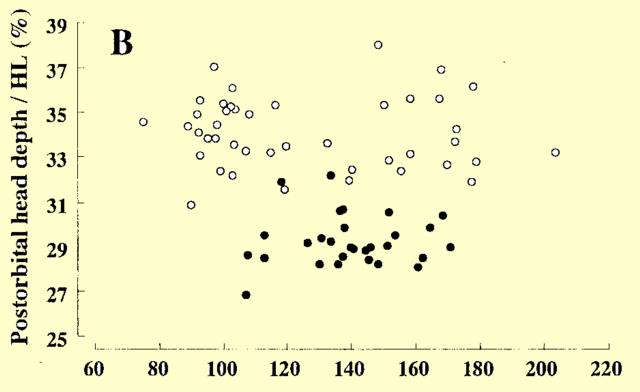 | Fig.7b: Relationship between standard length and percentage of postorbital head depth to head length (Black == C. panaw, White == C. punctata). |
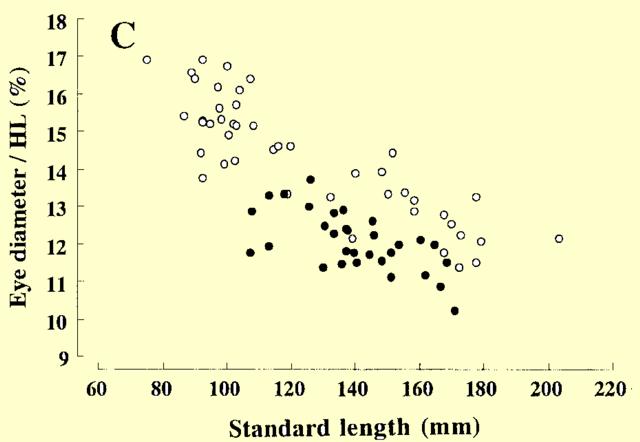 | Fig.7c: Relationship between standard length and percentage of eye diameter to head length (Black == C. panaw, White == C. punctata). |
1 Holotype of Channa panaw sp. nov.. Back
2 Syntypes (107.5mm SL, 152.0mm SL) of C. punctata . Number of predorsal scales of a syntype (107.5 mm SL) of C. punctata not counted because of damage to head region. Back
3 Holotype of Channa panaw sp. nov.. Back
4 Syntype (107.5mm SL) of C. punctata . Back
5 Syntype (152.0mm SL) of C. punctata . Back
6 Holotype of Channa panaw sp. nov.. Back
7 Syntype (107.5mm SL) of C. punctata . Back
8 Syntype (152.0mm SL) of C. punctata . Back
9 Syntype (107.5mm SL) of C. punctata . Back
10 Syntype (152.0mm SL) of C. punctata . Back
11 Holotype of Channa panaw sp. nov.. Back
12 Syntype (152.0mm SL) of C. punctata . Back
13 Holotype of Channa panaw sp. nov.. Back
14 Syntype (107.5mm SL) of C. punctata . Back
15 Syntype (152.0mm SL) of C. punctata . Back
16 Including holotype or syntypes. Back
17 Including holotype or syntypes. Back
18 Including holotype or syntypes. Back
19 Including holotype or syntypes. Back
20 Including holotype or syntypes. Back
33 Including holotype or syntypes. Head depth, head width, preorbital head depth, post orbital head depth, and interorbital width of syntype C. punctata (107.5 mm SL) not measured becasuse of damage to head region. Specimens under 100.4 mm SL not included. Back
34 Including holotype or syntypes. Head depth, head width, preorbital head depth, post orbital head depth, and interorbital width of syntype C. punctata (107.5 mm SL) not measured becasuse of damage to head region. Specimens under 100.4 mm SL not included. Back
35 Including holotype or syntypes. Head depth, head width, preorbital head depth, post orbital head depth, and interorbital width of syntype C. punctata (107.5 mm SL) not measured becasuse of damage to head region. Specimens under 100.4 mm SL not included. Back
36 Including holotype or syntypes. Head depth, head width, preorbital head depth, post orbital head depth, and interorbital width of syntype C. punctata (107.5 mm SL) not measured becasuse of damage to head region. Specimens under 100.4 mm SL not included. Back
37 Including holotype or syntypes. Head depth, head width, preorbital head depth, post orbital head depth, and interorbital width of syntype C. punctata (107.5 mm SL) not measured becasuse of damage to head region. Specimens under 100.4 mm SL not included. Back
This text was originally under the above title published in: Ichthyological Research, vol. 45, no.4; pp. 355-362 . The Ichthyological Society of Japan has granted snakeheads.org the right to publish it on the org's site. The copyright of text and photos is still with the Society in full amount.
| © 2001 - 2003 snakeheads.org | HOME of this page |